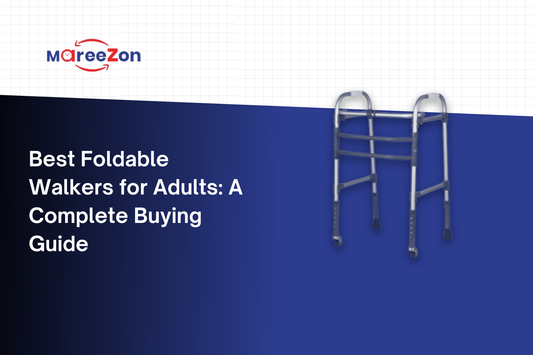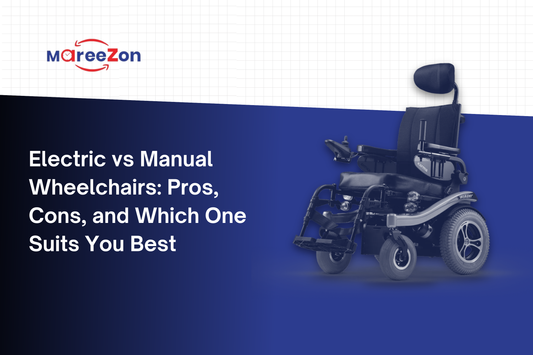Introduction: Supporting the Journey of Care
Namaste! Caring for a bedridden loved one can be a challenging and deeply personal experience. Whether you're helping elderly parents, a family member recovering from surgery, or someone with limited mobility, the right mobility solutions can make caregiving easier, safer, and more dignified for everyone involved.
The Daily Challenges of Caregiving
Common Scenarios Caregivers Face
Many families in India experience these situations:
-
"Moving Papa from bed to chair feels like a struggle every day."
-
"We worry about hurting Maa while transferring her."
-
"Taking someone to the bathroom safely is becoming harder."
-
"We need solutions that work in our small home."
Impact on Family Life
Mobility challenges don’t just affect the patient; they impact the entire household:
-
Physical strain on caregivers
-
Emotional stress for the patient
-
Difficulties managing time and routines
-
Space limitations in Indian homes
-
Financial constraints while seeking solutions
Understanding Modern Mobility Solutions
Essential Features to Consider
Safety and Stability
-
Weight Capacity: Ensure the equipment can handle the patient's weight safely.
-
Anti-Tip Mechanisms: Prevent accidental falls during use.
-
Emergency Brakes: Offer control during transfers or movement.
Comfort and Ergonomics
-
Cushioned Seating: Reduces discomfort during long use.
-
Pressure Distribution: Helps prevent bedsores or skin issues.
-
Temperature-Friendly Materials: Suitable for India's climate.
Practical Usability
-
Ease of Operation: Simple mechanisms for caregivers.
-
Compact Storage: Essential for smaller homes.
-
Versatility: Adaptable for different uses like transfers, bathing, or outdoor trips.
Detailed Mobility Solutions
1. Patient Transfer Chairs
Key Benefits:
-
Simplifies daily transfers
-
Reduces physical strain on caregivers
-
Offers patient dignity during movement
-
Suitable for small spaces and tight rooms
Perfect For:
-
Moving between bed and chair
-
Assisting with bathroom routines
-
Transfers within compact home spaces
2. Hydraulic Patient Lifts
Advantages:
-
Minimizes caregiver effort with hydraulic lifting
-
Ensures patient safety during transfers
-
Can be used for multiple purposes (bed-to-chair, bathroom)
-
Durable and stable, even for heavier patients
Ideal For:
-
Long-term care at home
-
Single caregiver households
-
Homes with enough room for equipment
3. Reclining and Tilt Wheelchairs
Features to Consider:
-
Offers recline and tilt functions for added comfort
-
Prevents pressure sores with better positioning
-
Adjustable footrests and headrests
Best Used For:
-
Long-duration seating
-
Travel outside the home
-
Improved positioning for comfort and health
Making the Right Choice
Assess Specific Needs
-
Patient Needs:
-
Weight and height of the patient
-
Level of mobility or assistance required
-
Medical conditions affecting posture or movement
-
Home Environment:
-
Available space for equipment
-
Doorway widths and storage options
-
Floor surfaces (tiles, carpets, etc.)
-
Caregiver Abilities:
-
Physical strength and availability
-
Comfort with operating equipment
-
Access to support from other family members
Practical Tips for Implementation
Setting Up Your Home
Space Organization:
-
Clear pathways for easy movement
-
Remove rugs or obstacles to prevent accidents
-
Install grab bars in bathrooms and hallways
Daily Routine Planning:
-
Schedule regular transfers
-
Include rest periods for caregivers and patients
-
Ensure availability of emergency contacts
Maintenance Guidelines
Regular Checks:
-
Inspect wheels, brakes, and joints for wear
-
Clean cushions and upholstery to prevent bacteria buildup
-
Lubricate moving parts for smooth operation
Seasonal Care:
-
Protect equipment from humidity during monsoons
-
Avoid heat exposure during summers
-
Store indoors to maintain durability
Special Considerations for Indian Homes
Space Management:
-
Use multi-functional equipment like transfer chairs with commodes.
-
Opt for foldable or compact designs.
Cultural Adaptations:
-
Ensure mobility solutions fit seamlessly into family gatherings and religious practices.
-
Allow for privacy and respect during caregiving routines.
Financial Planning
Understanding Costs:
-
Initial Investment:
-
Equipment purchase
-
Installation and setup costs
-
Long-Term Costs:
-
Maintenance and repair
-
Upgrades or spare parts
-
Accessories like cushions or covers
Building a Care Network
Family Support:
-
Share caregiving duties among family members.
-
Provide training for operating equipment.
-
Create backup plans for emergencies.
Professional Help:
-
Find reliable technicians for maintenance.
-
Consult healthcare providers for recommendations.
-
Join caregiver support groups for advice and emotional support.
Conclusion: Take the Next Step Towards Comfort and Safety
Finding the right mobility solution for a bedridden loved one can significantly improve their quality of life and ease the strain on caregivers. Here's how to start:
-
Evaluate the patient’s specific needs and your home environment.
-
Choose solutions that prioritize safety, comfort, and usability.
-
Plan for long-term maintenance and support.
At Mareezon, we’re here to help you every step of the way with genuine products, expert guidance, and seamless installation. Explore our range of mobility solutions today and make caregiving a smoother, more rewarding experience.










